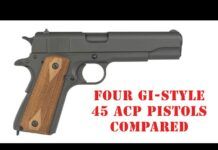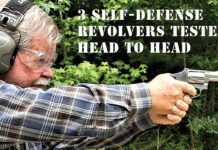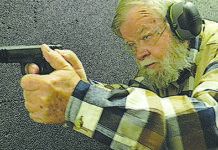For those people who want the largest pistol on the block — and perhaps in town — the .500 S&W Magnum is your caliber.According to the Bureau of Alcohol Tobacco, Firearms, and Explosives (BATFE) regulations, rifle and handgun bores are limited to one-half inch, unless the firearm is registered as a destructive device and a Federal $200 tax is paid and all other requirements are met. Translation: Don’t plan on seeing .550 or .600 magnum revolvers in the near future. Some other manufacturer could make a longer cartridge, but the overall length on the .500 S&W magnum is already over 2 inches long, and it accommodates bullet weights from light 275-grain hollow points to heavy 400-grain platinum-coated bullets. Such bullets require big launching pads, and we recently acquired two guns that fit the bill, in shorter barrel lengths suitable to uses other than hunting. We acquired Taurus and Smith & Wesson 4-inch-barrel double action revolvers, namely the Taurus Raging Bull .500 Magnum No. 500MSS4, $934; and the Smith & Wesson .500 S&W Magnum No. 163504, $1256. These revolvers generated a lot of interest among shooters. The two most common questions we heard at the range were “Can I have a shot?” and “What do you use that revolver for?” We were more than happy to let a variety of shooters, ranging from teenagers to senior citizens, try out these guns, and we noted their impressions. However, we couldn’t talk any women into shooting these monsters. Also, very few shooters wanted to take a second shot.
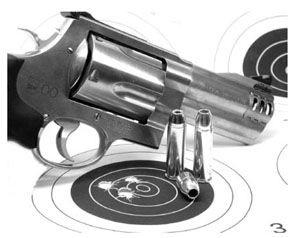
Our favorite answer to the second question was to say we’d use the guns for “concealed-carry self-defense,” then we would all laugh. Of course we don’t recommend these guns for concealed carry because of their large size and deep penetrating power. As witness to their punch, we handloaded the lightest bullet (Barnes X 275-grain XPB) with the lightest powder charge recommended (11.0 grains of Hodgdon Titegroup) and fired it into 1-gallon containers of water. Our load produced a velocity of 1,000 fps (400 fps less than Cor-Bon) and a muzzle energy of 600 foot-pounds (half the power of Cor-Bon’s 1200 foot-pounds). This was the most comfortable and easily controlled load of all the ones we tested. The most recoil-sensitive shooters had no problem shooting this load.
All that in consideration, we recovered the bullet from inside the sixth jug, which equates to 33 inches of penetration, far exceeding our recommendation of 12 inches. The recovered bullet did not expand or lose any weight. Some people feel that this gun would be suited for bear defense, and based on what we experienced, that seems about right.
If you think the .500 S&W Magnum is simply a larger version of the .44 Magnum round you would be mistaken. The cartridge overall length (COL) of the .44 Magnum is 1.6 inches, whereas the COL of the .500 S&W Magnum is 2.085 inches. The muzzle energy is substantially different. Winchester’s most potent load for the .44 Magnum is a 250-grain platinum-tip hollowpoint (#816160, $20.49 for 20 rounds) which has a listed velocity of 1250 fps and muzzle energy of 867 foot-pounds. Winchester’s .500 S&W Magnum 400-grain platinum-tip hollow point (#361538, $40.49 for 20 rounds) has a listed velocity of 1800 fps and muzzle energy of 2877 foot-pounds — more than three times the energy of the .44 Magnum! The listed velocities were based on revolvers with 8-inch barrels. Our recorded velocities were approximately 300 to 400 fps less with 4-inch barrels.
Here’s what we learned:
Taurus Raging Bull
.500 Mag. No. 500MSS4, $934
Taurus makes the .500 Magnum (without the S&W designation) in four barrel lengths (2, 4, 6, and 10 inches).We choose the 4-inch model because it seemed to give the best balance of “tote-ability” and ease of draw, yet still have enough barrel length to burn most of the powder. The matte stainless steel finish was preferred by about a quarter of the shooters due to its low-glare characteristics, but most preferred the satin stainless finish of the Smith for asthetic reasons.
The soft rubber grips were distinctive with a red strip down the back. The finger grooves were not as deeply cut as they were on the Smith. The majority of our team felt they were adequate for the 275-grain ammo, tolerable with the 325-grain spitzers, but painfully inadequate with the 400-grain hollow points. The Taurus weighed 13 ounces more than the Smith (according to spec sheets), but the additional weight did not seem to dampen the recoil.
About a third of our test team preferred the Taurus’s adjustable rear sight. The front ramp and rear sight were both plain black. When one of our testers decided to try a quick second shot with a 400-grain round, he found the sharp rear sight embedded in his forehead when he could not hold the gun back. Luckily, he only suffered a flesh wound and lost a little blood, but it could have been much worse. Accordingly, we suggest starting shooters with the lightest load possible in this revolver.
The compensator has two rows of vertical holes at the end of the barrel. This design seemed to produce less muzzle flash than the Smith, but the compensator didn’t reduce muzzle flip as much as we’d like. The gun rode up on all our shooters, even with the lightest loads.
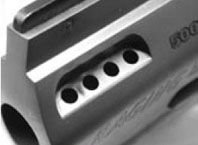
Also, opening the cylinder was a two-handed chore which required instruction. In addition to the standard thumb latch located behind the cylinder, there is another latch in front of the cylinder that must be pushed down simultaneously as you push in on the thumb latch and push the cylinder out from the opposite side of the gun. None of our testers cared for this feature, but with practice you could get used to it.
The cylinder locked closed in the usual manner. Unloading the cylinder was no problem with brass cases, but Winchester’s nickel cases had to be hammered out part way and then pulled out with pliers. After close inspection of the chambers, we could see tool marks in the chambers which scored the nickel cases. The chambers would need to be polished smooth to resolve this problem, a job any new gun owner shouldn’t have to do.
The double-action trigger pull seemed heavier than the Smith’s, but was smooth enough. The single-action pull broke cleanly, but most testers felt the Smith’s was better.
We performed our accuracy testing at 25 yards using a pistol rest, but not a Ransom Rest because of the guns’ recoil. The Raging Bull was not nearly as accurate as the Smith, and in our view, the sights, trigger, and grips all contributed to wider group sizes.
Smith & Wesson
.500 S&W Magnum
No. 163504, $1256
Smith & Wesson makes the .500 S&W Magnum in four barrel lengths (2.5, 4, 8 3/8, and 10.5 inches.) The 2.5-inch model is sold as part of an emergency survival kit (No. 163503, $1399) which includes a book titled Bear Attacks of the Century.
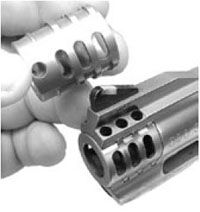
The satin-stainless finish was alluring to most shooters. Even those that declined to shoot it agreed that it was the better looking gun, but our focus is on performance. Although according to the spec sheets this gun weighed 13 ounces less than the Taurus, most testers agreed that it was clearly less punishing to shoot with heavy loads than its competition. The Hogue Sorbothane Recoil Absorbing Grips have deep finger grooves and fit most of our shooters’ hands better than the Taurus did. The grips were very effective, and we found shooting the 275-grain ammo was comfortable, the 325-grain ammo was manageable, and the 400-grain Winchester ammo ranged from uncomfortable to somewhat painful, but clearly better than the Taurus.
The adjustable rear sight had a white outline and the front sight had a red insert, which most of our shooters preferred over the Taurus’s plain black sights. The rear sight on the Smith was not as sharp as the Taurus, but none of our testers choose to try it out in the forehead.
The muzzle compensator has a removable insert. We tested the compensator designed for jacketed bullets. It has holes on the top and both sides. The other insert (not tested) is designed for cast lead bullets and only has holes on the sides. Considering the high cost of jacketed bullets (approximately one dollar each), cast lead bullets could be a good lower cost alternative. To change the insert, insert the supplied Allen wrench into a hole just under the muzzle and follow the illustrated directions on a supplied card. The muzzle flash was more noticeable on this revolver than on its competition, but it was not blinding by any means. The Smith seemed to exhibit less muzzle flip for most testers. It is hard to say if that could be wholly attributed to a better compensator or if it was simply the result of better grips.
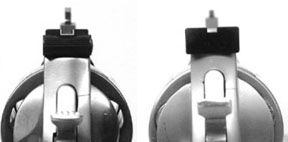
The Smith uses a standard thumb latch to unlock the cylinder. It can easily and instinctively be opened with one hand. The chambers on this gun were well polished at the factory, and we had no problems with nickel-cased ammunition. All the cases slid right out, and the gun worked flawlessly. The double-action trigger pull was smooth, but most shooters chose to use the light crisp single-action pull. Accuracy was outstanding with the Cor-Bon 325-grain spitzer ammunition with a 0.7-inch group. Indeed, it was accurate with everything we fed it (see table).
Gun Tests Recommends
x
Taurus Raging Bull .500 Magnum No. 500MSS4, $934, Don’t Buy. Any way you slice it, from the grips, to the sights, to the poor accuracy, and worst of all, scored chambers that required pliers to remove nickel cases, this gun doesn’t cut the mustard, in our opinion.
Smith & Wesson .500 S&W Magnum No. 163504, $1256. Conditional Buy. This gun has beauty, power, and accuracy. This impressive revolver is worth the price tag — if you have a need for its power. But it’s expensive to shoot, and some loads are simply too powerful for most shooters to handle. Let the buyer beware. GT
By Gun Tests Staff




